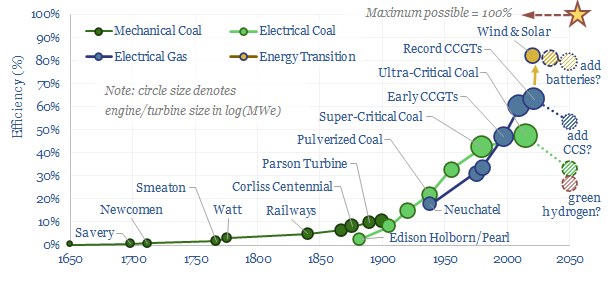How has the efficiency of prime movers increased across industrial history? This data-file profiles the continued progress in the efficiency of power generation over time, from 1650 to 2050e. As a rule of thumb, the energy system has shifted to become ever more efficient over the past 400-years.
In the early industrial revolution, mechanical efficiency ranged from 0.5-2% at coal-fired steam engines of the 18th and 19th centuries, most famously Newcomen’s 3.75kW steam engine of 1712. This is pretty woeful by today’s standards. Yet it was enough to change the world.
Electrical efficiency started at 2% in the first coal-fired power stations built from 1882, starting at London’s Holborn Viaduct and Manhattan’s Pearl Street Station, rising to around 10% by the 1900s, to 30-50% at modern coal-fired power generation using pulverised, then critical, super-critical and ultra-critical steam.
The first functioning gas turbines were constructed in the 1930s, but suffered from high back work ratios and were not as efficient as coal-fired power generation of the time. Gas turbines are inherently more efficient than steam cycles. But realizing the potential took improvements in materials and manufacturing. And the best recuperated Brayton cycles now surpass 60% efficiency in world-leading combined cycle gas turbines.
Renewables, such as wind and solar, offer another step-change upwards in efficiency, and will harness over 80% of the theoretically recoverable energy in diffuse sunlight and blowing in the wind (i.e., relative to the Betz Limit and Shockley-Queisser limit, respectively).
There is a paradox about many energy transition technologies. Long-term battery storage and green hydrogen would depart quite markedly from the historical trend of ever-rising energy efficiency in power cycles. Likewise, there are energy penalties for CCS.
The data-file profiles the efficiency of power generation over time, noting 15 different technologies, their year of introduction, typical size (kW), mechanical efficiency (%), equivalent electrical efficiency (%) and useful notes about how they worked and why they matter.

